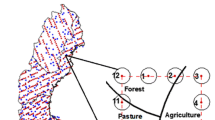Abstract
A FLORES-type model in the Simile modelling environment is being developed for three villages in the Humid Forest Benchmark area of southern Cameroon. The modelling project seeks to investigate the effects of introduction of new crop varieties and improved farming systems on the long-term maintenance of stable mosaics of forest and agriculture, within the context of the international Alternatives to Slash and Burn programme. Biophysical data have been collated, and socio-econnomic and tenure data have been acquired in spatially-explicit ways. Maps of land-cover at village and benchmark scale are being prepared from detailed and semi-detailed satellite imagery, using a nested legend system that allows linking of maps at different scales. These data enable the initial construction and parameterisation of the model, and will permit the extrapolation of the results of modelling from the villages to the benchmark, and ultimately to the whole of the Congo Basin humid forests. The prototype version of the model involves 10 households and about 500 land patches, and includes the three agricultural systems dominant in the southern more forested portion of the Benchmark (mixed food-fallow systems, forest melon fields, cocoa plantations) with no rental, sale or other transfer of land. Decision-making at the household level is essentially modelled deterministically, and labour productivity is assumed to be constant between households. This model is now complete, and once it has been adjusted and suitably parameterised, it will be applied to real data from the three test villages. This will require the addition of new farming systems, the introduction of modes of permanent or temporary transfer of land, and modification of the decision model to render it more realistic.
Similar content being viewed by others
References
Achard, F., Eva, H.D., Stibig, H-J., Mayaux, P., Gallego, J., Richards, T. and Malingreau, J-P. (2002), ‘Determination of deforestation rates of the world’s humid tropical forests’,Science, 297(5583): 999–1002.
Carpenter, S., Brock, W. and Hanson, P. (1999), ‘Ecological and social dynamics in simple models of ecosystem management’,Conservation Ecology, 3(2): 4, http://www.consecol.org/vol3/iss2/art4, accessed 30 January 2003.
Di Gregorio, A. and Jansen, L.J.M. (2000),Land Cover Classification System: Classification Concepts and User Manual, FAO, Rome.
Douthwaite, B., Weise, S., Gockowski, J., Keatinge, D., Manyong, V. and Baker, D. (2001), ‘IITA’s benchmark approach: Putting INRM into practice’, 2nd INRM Workshop, CIAT, Cali, Colombia, August 2001.
Dury, S. (1999), ‘Les conditions economiques d’adoption d’innovations agro-forestieres: Le cas de l’aboriculture fruitiere au centre de Cameroun’, Rapport IRAD-IITA-CIRAD, Yaounde, Cameroon.
Dury, S., Gautier, N., Jayet, E., Mba, M., Tchamba, C., Tsafack, G. (2000), ‘La consommation alimentaire au Cameroun en 1996’, Rapport ECAM, CIRAD-DSCN-IITA, Yaounde, Cameroon.
Gabaix, J. (1966), ‘Le niveau de vie des populations de la zone cacaoyere de Centre Cameroon’, Enquete 1964–65, SEDES, Paris.
Gockowski, J. and Baker, D. (1996), ‘An ecoregional methodology for targetting resources and crop management research in the humid forests of Central and West Africa’, Paper presented at the 1996 biennial meeting of Rockefeller social science research fellows, 15–17 August, Nairobi.
Jones, A., Seville, D. and Meadows, D. (2002), ‘Resource sustainability in commodity systems: The sawmill industry in the Northern Forest’,System Dynamics Review, 18(2): 171–204.
Legg C. and Robiglio, V. (2001), ‘Spatially explicit modeling of landscape change at the humid forest margin in Cameroon’, 2nd INRM Workshop, CIAT, Cali, Colombia, August 2001.
Leplaideur, A. (1985), ‘Les systemes agricoles en zones forestieres: les paysan de centre et du sud Cameroon’, IRAT, Montpelier.
Levins. R. (1966), ‘The strategy of model building in populations biology’,American Scientist, 54(4): 421–431.
Lynam, T., Bousquet, F., Le Page, C., d’Aquino, P., Barreteau, O., Chinembiri, F. and Mombeshora, B. (2002), ‘Adapting science to adaptive managers: Spidergrams, belief models, and multi-agent systems modeling’,Conservation Ecology 5(2): 24, http://www.consecol.org/vol5/iss2/art24, accessed 30 January 2003.
Muetzelfeldt, R.I. and Taylor, J. (1997), ‘The suitability of AME for agroforestry modelling’,Agroforestry Forum, 8(2): 7–9.
Muetzelfeldt, R.I. and Taylor, J. (2001), ‘Developing forest models in the Simile visual modelling environment’, Paper to IUFRO conference onForest Biometry, Modelling, and Information Science, Greenwich, June 2001, http://www.ierm.ed.ac.uk/simile/documents/iufro3.pdf, accessed 30 January 2003.
Oxley, T. and Lemon, M. (2000), ‘An integrative modeling framework, from social enquiry to decision support tools’, International Conference onThe Future of the Mediterranean Rural Environment: Prospects for Sustainable Land Use and Management, Menemen, Turkey, May 2000.
Prabhu, R., Haggith, M., Mudavanhu, H., Muetzelfeldt, R., Standa-Gunda, W. and Vanclay, J.K. (2003), ‘ZimFlores: A model to advise co-management of the Mafungautsi Forest in Zimbabwe’,Small-scale Forest Economics, Management and Policy, 2(2): 185–210.
Robiglio, V., Mala, W.A. and Diaw, M.C. (2003), ‘Mapping landscapes: Integrating GIS and social science methods to model human-nature relationships in southern Cameroon’,Small-scale Forest Economics, Management and Policy, 2(2): 171–184.
Vanclay, J.K., Haggth, M. and Colfer, C. (2003a), ‘Participation and model-building: Lessons learned from the Bukittinggi workshop’,Small-scale Forest Economics, Management and Policy, 2(2): 135–154.
Vanclay, J.K., Prabhu, R. and Sinclair, F. (2003b), ‘Modelling interactions amongst people and forest resources at the landscape scale’,Small-scale Forest Economics, Management and Policy, 2(2): 117–120.
Van Noordwijk, M. (2002), ‘Scaling trade-offs between crop productivity, carbon stocks and biodiversity in shifting cultivation landscape mosaics: the FALLOW model’,Ecological Modelling, 149: 113–126.
Author information
Authors and Affiliations
Additional information
The work described in this paper is a part of a project funded by the European Union through ICRAF and hosted at the IITA Humid Forest Ecoregional Centre, Cameroon. The assistance of Valentina Robiglio (JPO GIS specialist), especially in preparation of land-cover maps and in collection of socio-economic data, is gratefully acknowledged, as is the work of IITA ASB village facilitators in collection of field data. The cooperation of IITA, IRAD, CIFOR and ICRAF scientists in providing data for the model and periodically reviewing progress with the modelling process was essential to the progress achieved thus far.
Rights and permissions
About this article
Cite this article
Legg, C. CamFlores: A FLORES-type model for the humid forest margin in Cameroon. Small-scale Forestry 2, 211–223 (2003). https://doi.org/10.1007/s11842-003-0016-4
Issue Date:
DOI: https://doi.org/10.1007/s11842-003-0016-4




